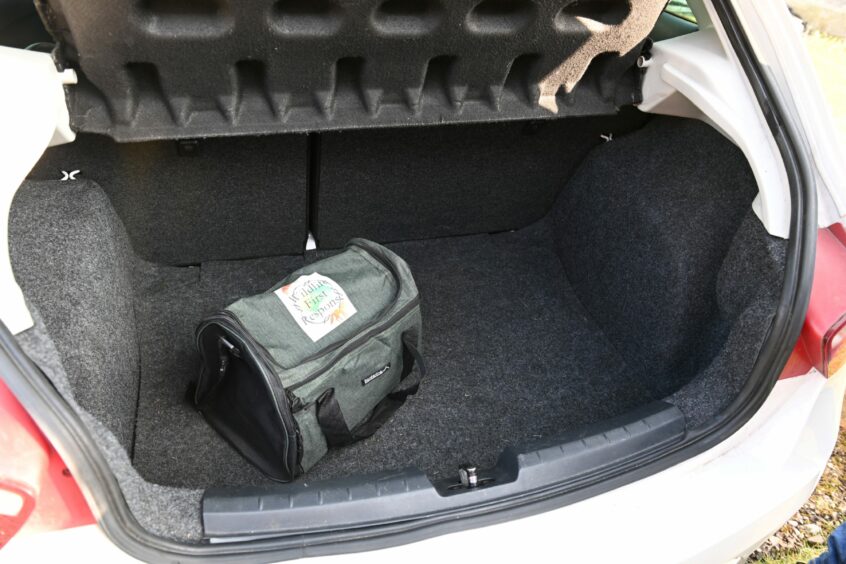A husband and wife duo have created an all-in-one kit designed to help save injured wildlife that has been backed by television star Chris Packham.
Hannah and Ryan Darnell from Potterton started up their Wildlife First Response initiative last November after years of transporting hurt or poorly animals to their local rescue centre.
The couple designed their bags of specialist equipment to be left in car boots, so that drivers have all they need to give creatures that have survived road collisions the best chances for survival before they are taken safely to professionals for care.
And despite only launching last year, their project has already caught the eye of a high-profile conservationist.
Chris Packham, of BBC Springwatch fame, has already procured one of the kits and says it’s now got pride of place in his car boot in case he ever comes across some not-quite-dead animal road victims.
Filled with useful tools like nets, blankets and head torches, the Wildlife First Response bags come equipped with almost everything a rescuer would need.
How does it work? Watch as Chris Packham explains:
Hannah and Ryan said the kits are not designed to give animals first aid at the roadside, but to get them safely into a position where they can be taken to professionals like a vet or wildlife hospital.
All the bits and bobs included in the four kilogramme heavy (8.8lbs) kit are there to ensure the safety of both the injured animal, and the kind person taking the time to help them in their time of need.
This graphic shows everything that’s included in the kit, and what it’s for:

Where did the idea come from?
Ryan and Hannah said they started up Wildlife First Response after years of coming to the aid of their local wildlife rescue centre in Aberdeenshire, The New Arc.
Whenever The New Arc would put out a call asking for someone to transport injured animals like rabbits, foxes or otters from far-flung roadsides into their care, the Darnells would “jump in the car and shoot off” to help.
Initially, the pair only brought a few pieces of equipment, but as they learned what they required most while volunteering, their own prototype kit bag became larger and larger.
Ryan, a customer support engineer when he’s not rescuing woodland critters said: “Back when we did it the most, it would be several times a week.”
“When we first started going out we’d just take the cat carrier and that was it.
“Then we packed in other things we realised we needed like shoeboxes, then blankets, then scissors, and before we knew it we had a bucket in the car stuffed full of bits and pieces.
“In time we thought… why can’t we offer something like this to other people?”
“We thought that if other people knew they had it in their car, they would have some incentive to stop, get involved, and make a difference if they came across any injured wildlife,” added Hannah, who is a full-time solicitor.
She continued: “I work in Turriff, so I’m out on a lot of rural roads all the time and come across so many dead animals by the side of the road… otters, squirrels, badgers, you name it, and it’s pretty much on a daily basis.
“It just got me thinking that we really wanted to do something more about this and help people make a change themselves.”
How is Wildlife First Response funded?
Hannah said that when she and Ryan established their project “it was never about money-making”.
“It was always, cheesy as it sounds, about making a difference,” she said.
“The kits are £49.99, but we want to try and get that lower if we can.
“We only make a couple of pounds off each kit, we both work full time so all the money we do make is reinvested into trying to come up with new ways to develop the message that we’re trying to get across here.”
She said that right now she thinks the price tag is a “bit of a barrier” to people buying kits, but hopes she can make them more affordable moving forwards.
How recent storms and loss of trees is making already bad situation worse for wildlife
Hannah and Ryan said that with the impact of recent storms all across Scotland felling thousands upon thousands of trees, many animals have been left homeless.
And with a need to travel out of their usual habitats to find new homes, Ryan said this puts them at risk of being killed by coming into contact with humans.
He added: “The storm damage has really destroyed a lot of habitats, especially here in Aberdeenshire.
“So we’ve got a situation where there will be a lot of wildlife moving areas, trying to find new suitable locations to live because their homes are destroyed.
“And that’s putting them into more danger when they come across roads.
“So the more we can be vigilant now, the more chance our wildlife has to thrive again.”
“We’re in a biodiversity crisis, so it’s really important to cherish what we’ve got,” added Hannah.”















